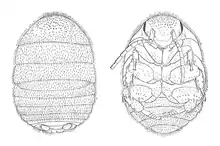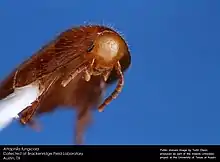Attaphila
Attaphila is a genus of cockroaches that live as myrmecophiles in the nests of leaf-cutting ants.[1] They have been suggested to feed on the fungus their host ants farm,[1][2][3] or on the cuticular lipids of ant workers.[4] Attaphila are not attacked by host workers because they blend into the colony by mimicking the odour of their hosts ants.[3] Female Attaphila are wingless and males have reduced wings. The cockroaches are phoretic and can disperse to new host colonies by riding on virgin host queens (female alates) departing on their mating flight[2] and by hitchhiking on leaves[5][6][7] carried by leaf-cutter ant foragers returning to their nests, or by following leaf-cutter ant pheromone trails[8]
| Attaphila | |
|---|---|
 | |
| Attaphila fungicola female | |
| Scientific classification | |
| Domain: | Eukaryota |
| Kingdom: | Animalia |
| Phylum: | Arthropoda |
| Class: | Insecta |
| Order: | Blattodea |
| Family: | Ectobiidae |
| Subfamily: | Blattellinae |
| Genus: | Attaphila Wheeler, 1900 |

Six species of Attaphila have been described:
- Attaphila fungicola Wheeler, 1900
- Attaphila bergi Bolívar, 1901
- Attaphila aptera Bolivar, 1905
- Attaphila schuppi Bolivar, 1905
- Attaphila sexdentis Bolivar, 1905
- Attaphila flava Gurney, 1937
References
- Wheeler, William Morton (November 1900). "A New Myrmecophile from the Mushroom Gardens of the Texan Leaf-Cutting Ant". The American Naturalist. 34 (407): 851–862. doi:10.1086/277806. ISSN 0003-0147.
- Phillips, Z. I.; Zhang, M. M.; Mueller, U. G. (2017-02-11). "Dispersal of Attaphila fungicola, a symbiotic cockroach of leaf-cutter ants". Insectes Sociaux. 64 (2): 277–284. doi:10.1007/s00040-016-0535-6. ISSN 0020-1812. S2CID 253645348.
- Nehring, Volker; Dani, Francesca R.; Calamai, Luca; Turillazzi, Stefano; Bohn, Horst; Klass, Klaus-Dieter; d’Ettorre, Patrizia (2016-08-05). "Chemical disguise of myrmecophilous cockroaches and its implications for understanding nestmate recognition mechanisms in leaf-cutting ants". BMC Ecology. 16 (1): 35. doi:10.1186/s12898-016-0089-5. ISSN 1472-6785. PMC 4974750. PMID 27495227.
- Waller, D.A.; Moser, John C. (1990). "Invertebrate enemies and nest associates of the leaf-cutting ant Atta texana (Buckley) (Formicudae, Attini)". In: Applied Myrmecology: A World Perspective, P. 256-273.
- Phillips, Z.I.; Reding, L.; Farrior, C.E. (2021). "The early life of a leaf-cutter ant colony constrains symbiont vertical transmission and favors horizontal transmission". Ecology and Evolution. 11 (17): 11718–11729. doi:10.1002/ece3.7900. ISSN 2045-7758. PMC 8427574. PMID 34522335.
- Phillips, Z.I. (2021). "Emigrating together but not establishing together: A cockroach rides ants and leaves". The American Naturalist. 197 (1): 138–145. doi:10.1086/711876. PMID 33417528. S2CID 225007111.
- "Catalogue of Life - 2011 Annual Checklist :: Search all names". www.catalogueoflife.org. Retrieved 2018-10-26.
- Moser, J. C. (1964-03-06). "Inquiline Roach Responds to Trail-Marking Substance of Leaf-Cutting Ants". Science. 143 (3610): 1048–1049. Bibcode:1964Sci...143.1048M. doi:10.1126/science.143.3610.1048. ISSN 0036-8075. PMID 17733069. S2CID 42538774.